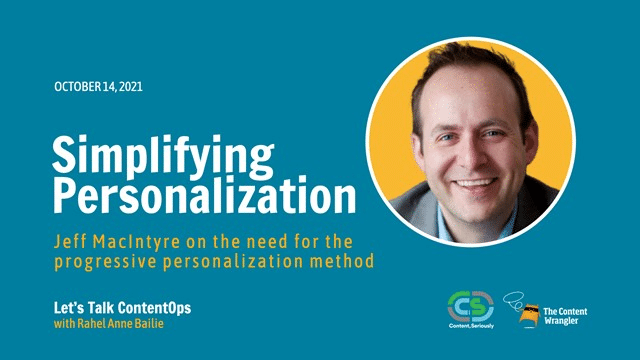Personalisation as a Connected Experience: An Interview with Jeff MacIntyre
We know from experience that when it comes to personalisation, there are all too many pitfalls. Take this example: “Dear Amazon, I bought a toilet seat because I needed one necessity, not desire. I do not collect them. I am not a toilet seat addict, no matter how temptingly you email me I’m not going to think Oh, go on there. Just one more toilet seat. treat myself. Yeah.” This example was supplied via Jeff MacIntyre of Bucket Studio, who finds these “perso-fails” amusing and frustrating. But more about this later.
Jeff sees a whole generation of work that has over-scoped the execution of personalization. The assumption was thinking that they can personalise all the things that they need to do for all the stuff. They then under-scope or descope the very things that would make their personalisation efforts successful, such as experience debt and information sciences. He posits that figuring out the personalisation problem is actually harder than figuring out the answers. He has developed some simple methods to getting the right personalization outcomes, and it all stems from how to get started. Returning to the Amazon example, the failure is not of personalisation itself, it’s a failure of classification. If you were being retargeted for toilet paper, a consumable, it might be a little more credible as a cadence in your reengagement technique. But a toilet seat is a household durable, not a consumable. So, Jeff observes, this is more of a taxonomy fail combined with an over-narrowing of a result.
Listen to the full discussion to understand the need for progressive personalization
Published: 12 Jan 2022
Duration: 54 min
Guest: Jeff MacIntyre
Host: Rahel Bailie
Listen to the full discussion –>
My own experience shows just how long we have to go before this type of personalisation really works. Clicking on an ad for clothing in the wrong size range doesn’t stop the ad from being shown to me ad nauseum. It was also bemusing to me to be targeted with products for middle-class African women for at least six months. It could have been mobile ad targeting – my mobile phone is often in close proximity to the mobile phone of my (Afro-EU) partner – but when I got the African-print head wraps (I have baby-fine hair that lays as flat as a pancake), the ads were simply casting a wide net and hoping for the best, but with little effectiveness.
Calling out the personalisation gap
This is called overfitting, according to Jeff, who notes that this is a race to see what the easiest way is to target a user. However, it breeds mistrust and, ultimately, failure. Instead, designing the personalisation to look at intention during looking versus buying, say, a head wrap, could back off the retargeting, and then re-engage you. It’s designing with data, which tends to get overlooked as part of the strategy.
I asked Jeff about the differences in how marketing teams and product teams considered personalisation. There is a difference between pre-sales and post-sales personalisation efforts. However, there are much more dramatic differences by business sector. Ecommerce is 10 to 15 years ahead of many other sectors in terms of understanding techniques, practices, data hygiene, and data quality. Even then, you need to consider whether you are operating in a sales context, a marketing context, or employee engagement context. These things are very determinant of what success looks like and the techniques you would undertake.
Organisations often try to personalise, whether that be ad retargeting, doing omnichannel delivery for different stages of a customer journey, or localising product content for different markets, by grasping at straws and trying things out without internal expertise. Jeff calls this the personalisation gap.
IA before AI
The personalisation gap is not about the technology; it’s about the expertise – a lack of experience in personalisation activities, and lack of subject matter experts. Take, for example, not addressing long-standing metadata debt in the organisation. Instead, there becomes a rather treacherous combination of overthinking the solution by deciding to go some big-bang route using artificial intelligence (AI). But having poor vocabularies unconnected to different systems of record doesn’t help reconcile the shortcomings of the current state of your Information Architecture (IA). Jeff’s mantra of “IA before AI” is because those systems must be connected at a certain level – that’s why it’s called connected experience. That means having multiple systems of record being able to string a single customer experience across them, which means being data-driven.
The idea that an organisation can deprioritise their taxonomy work and only use machine learning and AI on data an unstructured content is folly. I’m using the term in the context of British architecture, where some wealthy person would construct a building for decoration, with elaborate classical pretensions. They might go picnic at the folly, but otherwise, it was a quite useless construct. So we have these follies in personalisation where organisations are chasing the shiny things and ignore building a solid foundation. Follies won’t result in systems all magically working together. There needs to be a solid foundation laid before anyone builds on it, and taxonomy is part of that foundation.
Three on-ramps to get to personalisation
One of Jeff’s contributions to the profession is the creation of three different methods for putting effective personalisation into play. These on-ramps are meant to be contained explorations or pilots that will help validate the ROI, the business benefit, and the user benefit, before tackling things such as normalising all of the taxonomies or connecting all the subsystems.
Discussing personalisation as connected experience brings together the various ways that people talk about personalisation, which means different things to different people. For some people, talking about personalisation actually means automation. In other cases, people are thinking about altering the user experience, or it could mean customisation of content delivery. There is an on ramp for each one of those situations, to which Jeff has given musical terms. These aren’t meant to be sequenced but used as stand-alone methods. Different organisations will adopt different methods, depending on their maturity level at any given time.
The Solo – automation of some of the customer journey, creating a flow that leads to tangible benefits.
The Sonata – customisation through audience segmentation and analytics, to deliver custom views of content for particular audiences.
Symphony – classic personalisation in the form of content or product recommendations.
Jeff discusses these three on-ramps in detail on the webinar, where you can also find some slides about each of the on-ramps.
Connecting personalisation to content operations
Jeff emphasizes that the best outcomes from using these on-ramps is shining a light on content, assets, and elements, and showing their contribution to advancing a user. It has to remedy a user need more promptly or driving lift on conversion, so a business benefit is extremely important in for us to get an idea of content performance. In the end, you need to have a performance attribution revenue attribution element to any of the on-ramps.
The old adage of “you do not manage what you do not measure” is key when implementing personalisation. Measurement could be through Return on Investment (ROI) or Internal Rate of Return (IRR). At the risk of being overly reductionist, ROI is spending to earn money, while IRR is spending to save money. To measure well, this means building up operational efficiencies. This fits more in the IRR category, but organisations have traditionally been reluctant to think about improvement to business processes. Yet to measure the effectiveness of personalisation efforts, an organisation needs to consider organisational change for operational efficiencies.
For the full benefit of the explanations of the three on-ramps, elaboration on the benefit of operational improvements, you’re going to want to listen to the webinar. You can find it on the Let’s Talk ContentOps show, Simplifying Personalization, where it is available as an on-demand webinar.
Why do product managers need to understand content operations?
Download our 10 essential content operations tips for product managers
I want to learn about the benefits of ConetentOps –>
Learn more about personalisation:
ABOUT THE AUTHOR
Rahel Anne Bailie, Content, Seriously
Rahel is a results-driven, seasoned consultant with extensive experience in digital transformation. She has a strong track record of delivering end-to-end content systems in the context of digital strategy projects, often in environments with complex content delivery requirements. A professional who delivers the hard truths and sometimes difficult prescriptions that help organisations leverage their content as a business asset.
The post Personalisation as a Connected Experience: An Interview with Jeff MacIntyre appeared first on Content, Seriously Consulting Ltd..




